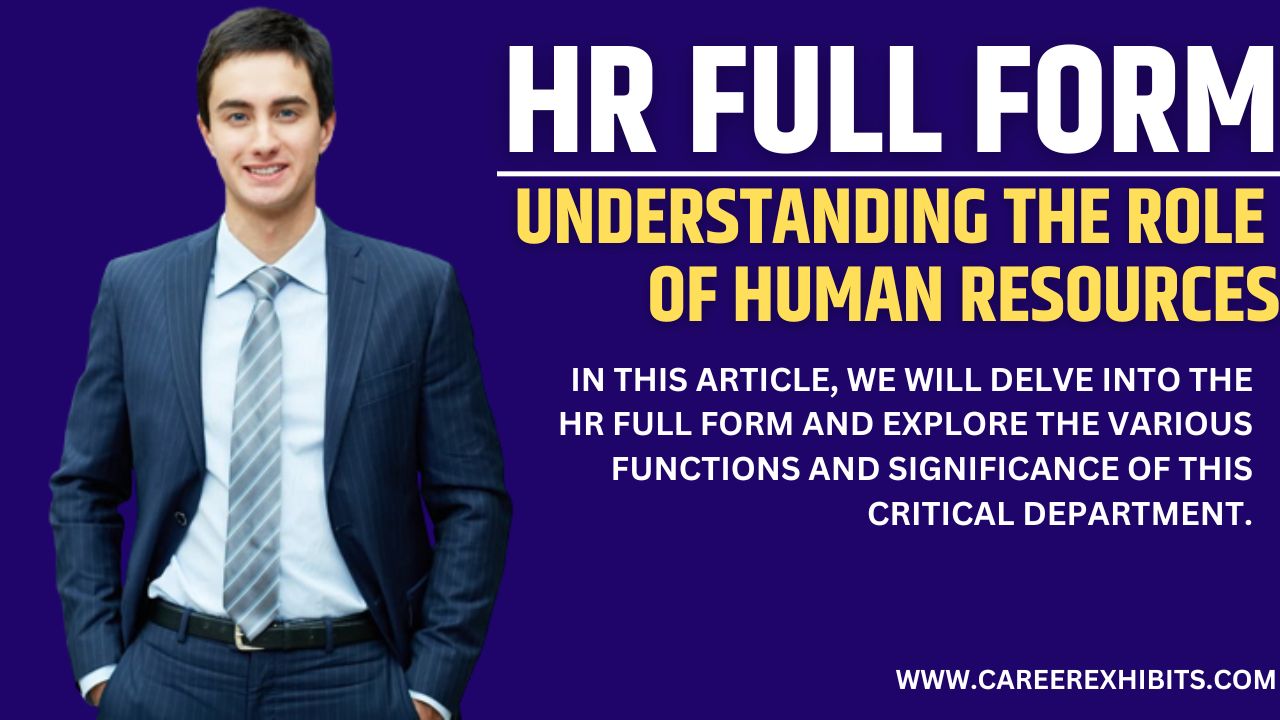Introduction: HR Full Form
Human Resources (HR) denotes the organizational department tasked with the management and supervision of diverse workforce components. HR involves a spectrum of responsibilities aimed at enhancing employee recruitment, growth, deployment, and welfare. This unit assumes a pivotal function in guaranteeing the efficient exploitation of an organization’s human assets to attain its ambitions and aims. From the enlistment and education of fresh personnel to the management of staff interactions, performance evaluation, provision of benefits, and beyond, HR experts strive to establish a fruitful and optimistic workplace that benefits both the staff members and the entire organization.

What is HR Full Form?
The full form of “HR” is “Human Resources.
HR Full Form in Hindi.
HR का फुल फॉर्म “Human Resource” होता हैं, जिसे हम अपनी भाषा में ‘ह्यूमन रिसोर्स’ के नाम से जानते हैं। बड़ी-बड़ी प्राइवेट कंपनियों तथा इंस्टीटूशन्स में HR समूह होता हैं जो कंपनी या इंस्टीटूशन्स में ह्यूमन सोर्स का कार्य करता हैं।
HR Career Path
The human resources manager career path is a rewarding one that offers many opportunities for growth and advancement. Here is a typical career path for a human resources manager:
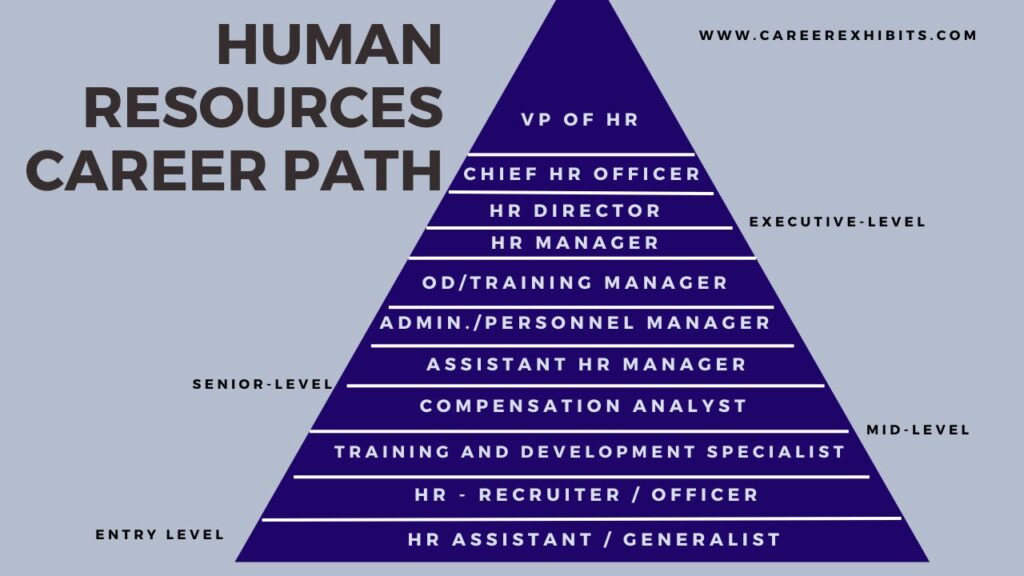
- Entry-level: Start as an HR assistant or generalist. This role will give you exposure to all aspects of HR, such as recruiting, onboarding, employee relations, and benefits administration.
- Mid-level: Move on to a more specialized role, such as HR recruiter, compensation analyst, or training and development specialist. This will allow you to develop your expertise in a particular area of HR.
- Senior-level: Become an HR manager. In this role, you will be responsible for overseeing all HR functions for a company. This includes developing and implementing HR policies and procedures, managing HR staff, and providing HR support to employees and managers.
- Executive-level: Advance to a senior HR position, such as vice president of HR or chief HR officer (CHRO). In this role, you will be responsible for setting HR strategy and leading the HR department for a large organization.
To become a human resources manager, you will need a bachelor’s degree in human resources, business administration, or a related field. You may also want to consider earning a master’s degree in human resources or business administration. In addition to your education, you will need to have strong analytical, problem-solving, and interpersonal skills. You should also be able to work independently and as part of a team.
The human resources manager career path is a great choice for people who are interested in working with people, helping others, and making a difference in the workplace. It is also a field that is growing rapidly, so there are many opportunities for advancement. If you are looking for a rewarding and challenging career, human resources management may be the perfect fit for you.
Here are some additional tips for advancing your career as a human resources manager:
- Get involved in professional organizations. This is a great way to network with other HR professionals and learn about new trends in the field.
- Stay up-to-date on HR regulations and laws. This is essential for ensuring that your company is compliant with all applicable laws.
- Earn professional certifications. This can demonstrate your expertise to employers and help you advance your career.
- Take on leadership roles. This will show your employers that you are capable of handling more responsibility.
- Be willing to relocate. This may be necessary to find the right HR management position.
What is HR Management?
Human Resources (HR) management refers to the strategic and operational activities involved in effectively managing an organization’s human capital. It encompasses a wide range of functions aimed at attracting, developing, and retaining employees while ensuring their well-being and compliance with employment laws and regulations. HR management plays a crucial role in creating a productive work environment and supporting the achievement of organizational goals.
Key Areas of HR Management
HR management involves various interconnected areas that work together to support the overall management of an organization’s workforce. These key areas include:
1. Recruitment and Selection

Recruitment and selection are fundamental aspects of HR management. HR professionals work to attract qualified candidates, assess their suitability for specific roles, and ultimately hire the best individuals for the organization. This process involves defining job requirements, sourcing candidates, conducting interviews, and making informed hiring decisions.
2. Employee Onboarding

Employee onboarding focuses on welcoming and integrating new employees into the organization. HR plays a critical role in providing orientation programs, introducing new hires to the company culture and values, and ensuring a smooth transition into their roles. Effective onboarding enhances employee engagement and accelerates their productivity.
3. Training and Development

HR management emphasizes the importance of continuous learning and development for employees. HR professionals identify training needs, design or source training programs, and deliver them to enhance employee skills and competencies. Training and development initiatives contribute to employee growth, engagement, and overall organizational performance.
4. Performance Management
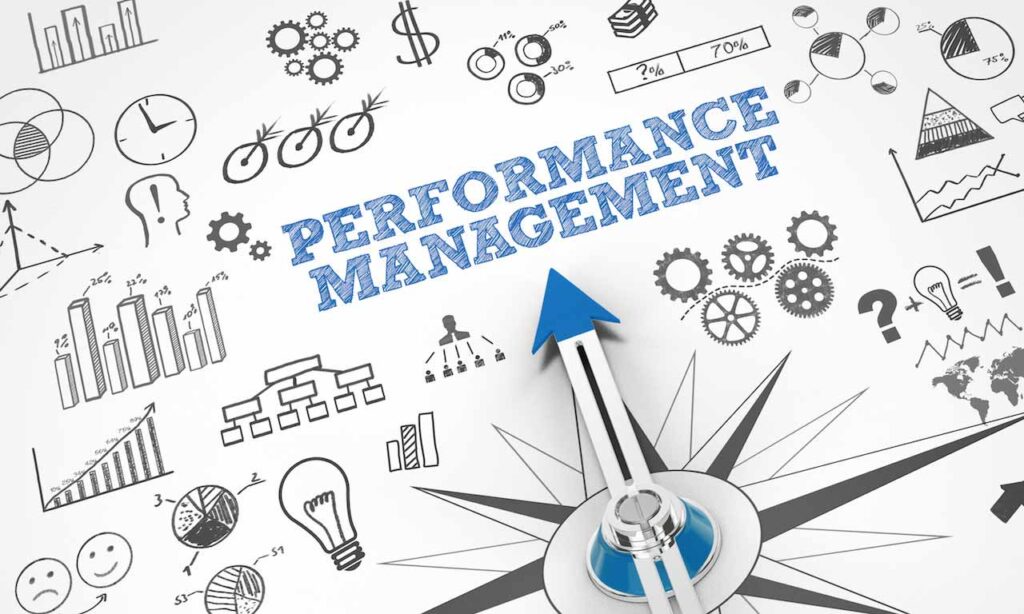
Performance management involves setting clear performance expectations, providing regular feedback, and evaluating employee performance. HR professionals work closely with managers to establish performance goals, conduct performance appraisals, and identify opportunities for improvement. Effective performance management promotes accountability, drives employee growth, and aligns individual performance with organizational objectives.
5. Compensation and Benefits
HR management ensures the establishment of fair and competitive compensation structures. HR professionals design and administer salary programs, bonuses, incentives, and benefits packages. They stay updated on industry trends and benchmarks to ensure that employees are fairly rewarded for their contributions.
6. Employee Relations

Maintaining positive employee relations is essential for a productive work environment. HR management focuses on fostering effective communication, addressing employee concerns, and creating a culture of respect and inclusivity. HR professionals mediate conflicts, handle disciplinary actions, and promote employee engagement and satisfaction.
7. HR Policies and Compliance
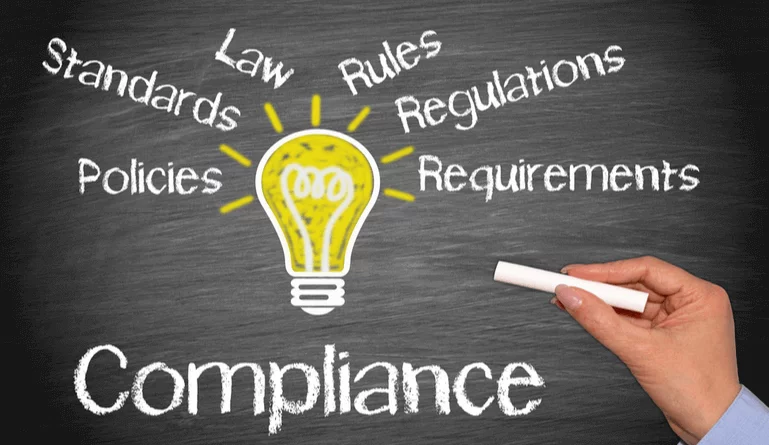
HR management involves developing and implementing HR policies and procedures that comply with employment laws and regulations. HR professionals stay updated on labor laws, employment standards, and best practices to ensure legal compliance. They play a critical role in communicating policies, enforcing guidelines, and handling employee-related legal matters.
8. Employee Engagement and Retention

HR management focuses on creating a positive work environment that fosters employee engagement and retention. HR professionals develop strategies to enhance employee satisfaction, well-being, and work-life balance. They implement initiatives such as recognition programs, career development opportunities, and work flexibility to ensure employees feel valued and motivated to stay with the organization.
9. HR Analytics
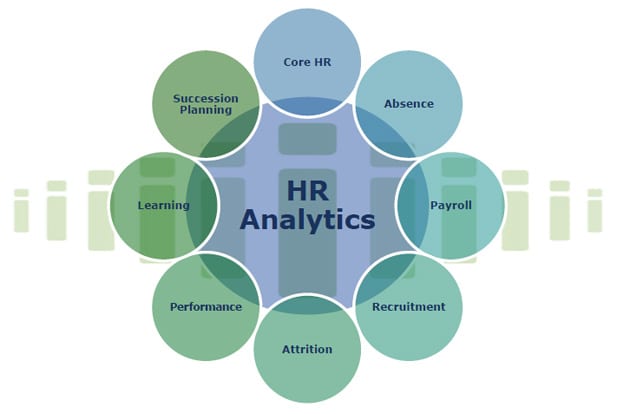
With the increasing availability of data, HR management incorporates HR analytics to drive informed decision-making. HR professionals use data-driven insights to analyze workforce trends, identify talent gaps, and develop strategies for talent acquisition, retention, and succession planning. HR analytics provide valuable insights into the effectiveness of HR initiatives and support evidence-based HR practices.
The Importance of HR Management
Effective HR management is crucial for organizations to attract and retain top talent, optimize employee performance, and create a positive work culture. HR professionals act as strategic partners, working closely with organizational leaders to align HR strategies with business goals. By focusing on employee development, engagement, and compliance, HR management contributes to the overall success and sustainability of the organization.
In conclusion, HR management encompasses a wide range of functions that support the effective management of an organization’s human capital. From recruitment to employee development, performance management to compliance, HR professionals play a vital role in ensuring the well-being and success of both employees and the organization as a whole.
What Does an HR Organization and Team Structure Look Like?
Human Resources (HR) plays a critical role in organizations by managing the people-related aspects of the business. To effectively fulfill their responsibilities, HR departments are structured in a way that allows them to address various needs and functions. In this article, we will explore the typical organization and team structure of an HR department.
Centralized vs. Decentralized HR Structure
The first decision organizations make regarding their HR structure is whether it will be centralized or decentralized.
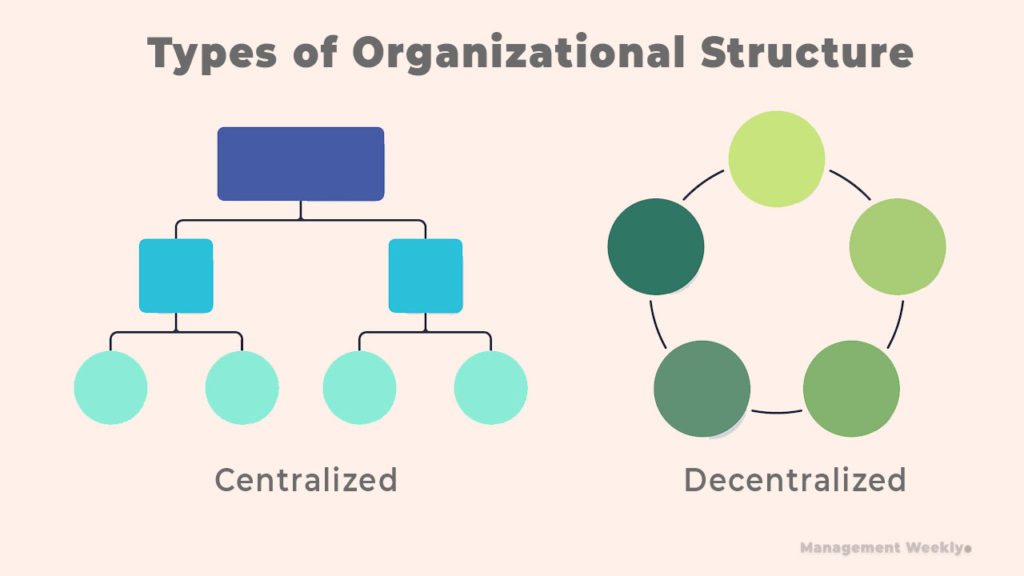
- In a centralized structure, HR functions are consolidated under a single department. This means that all HR-related activities, such as recruitment, training, and payroll, are handled by the central HR team. This structure ensures consistency and uniformity in HR practices across the organization.
- On the other hand, a decentralized structure involves HR functions being distributed among different departments or business units. In this model, each department has its own HR representative or team responsible for handling HR matters specific to that department. This structure allows for a more localized approach, with HR professionals closely aligned with the needs and goals of their respective departments.
The choice between centralized and decentralized HR structure depends on various factors such as the organization’s size, industry, and geographical spread.
Typical HR Department Structure
Regardless of whether an organization adopts a centralized or decentralized structure, HR departments generally consist of several key roles and teams. Here is a typical HR department structure:
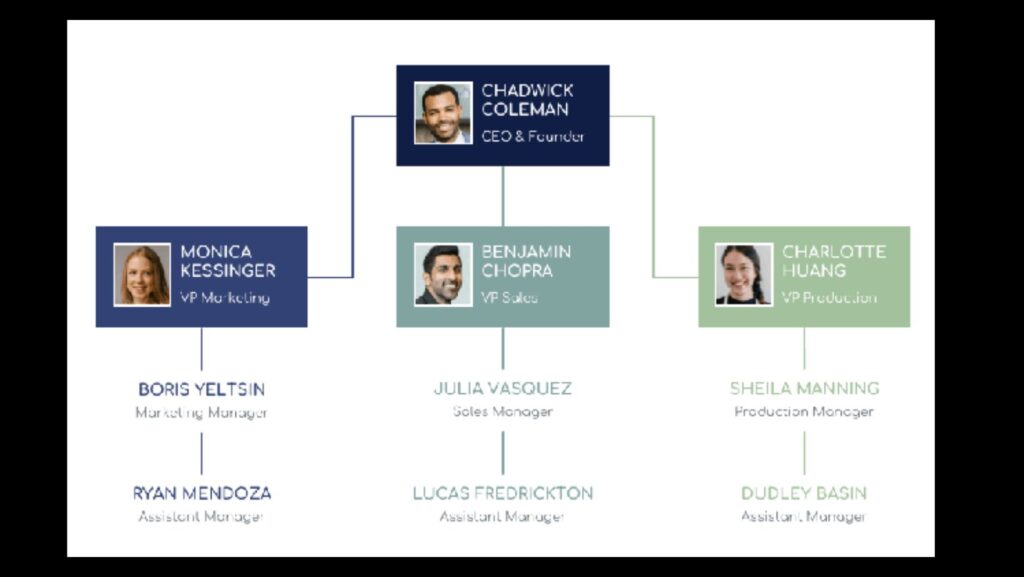
- HR Director/Manager: At the top of the HR hierarchy is the HR Director or Manager. This individual oversees the entire HR function and is responsible for setting the strategic direction of HR initiatives in alignment with the organization’s goals. They collaborate with senior management and play a crucial role in shaping the company’s people strategy.
- HR Business Partners: HR Business Partners work closely with the leaders of specific business units or departments. They act as liaisons between management and employees, providing guidance and support in areas such as employee relations, performance management, and talent development. HR Business Partners ensure that HR strategies are tailored to meet the unique needs of each business unit.
- Recruitment and Talent Acquisition Manager: This team is responsible for attracting and selecting qualified candidates to fill job vacancies within the organization. They develop job descriptions, advertise positions, screen resumes, conduct interviews, and facilitate the hiring process. They also collaborate with hiring managers to understand their talent needs and ensure a smooth recruitment experience.
- Training and Development Manager: The Training and Development team focuses on enhancing the skills and knowledge of employees. They identify training needs, design and deliver training programs, and support employee development initiatives. This team plays a crucial role in ensuring employees have the necessary competencies to excel in their roles and contribute to the organization’s success.
- Performance Management Manager: HR facilitates the performance management process, which includes setting performance goals, conducting regular performance evaluations, providing feedback, and recognizing and rewarding top performers. They also assist in addressing performance issues and implementing improvement plans when necessary.
- Compensation and Benefits Manager: The Compensation and Benefits team manages employee compensation structures, including salary, bonuses, and incentives. They also administer employee benefits programs such as health insurance, retirement plans, and leave policies. This team ensures fair and competitive compensation practices while staying compliant with relevant laws and regulations.
- Employee Relations Manager: The Employee Relations team is responsible for fostering positive relationships between employees and the organization. They handle employee grievances, address workplace conflicts, and mediate disputes. They also implement strategies to promote employee engagement, satisfaction, and overall well-being.
- HR Operations Manager The HR Operations team focuses on the administrative aspects of HR management. They handle tasks such as maintaining employee records, managing HR systems and technology, processing payroll, and ensuring compliance with HR policies and procedures. This team plays a critical role in
- HR Policies and Compliance Manager: Developing and implementing HR policies and ensuring compliance with employment laws and regulations are key functions of HR. They stay updated on changes in labor laws and work to create policies that promote fairness, equity, and legal compliance within the organization.
- Employee Engagement Manager: HR plays a vital role in fostering employee engagement and satisfaction. They organize events, initiatives, and programs that promote a positive work culture, encourage employee well-being, and enhance overall job satisfaction.
- HR Analytics Head: Leveraging data and analytics has become increasingly important in HR management. HR professionals use data-driven insights to make informed decisions about recruitment, employee performance, retention strategies, and overall workforce planning.
How to Start a Career in HR
Human Resources (HR) is a dynamic field that offers various opportunities for individuals interested in managing and supporting the people aspect of organizations. If you are considering a career in HR, here are some steps to help you get started:
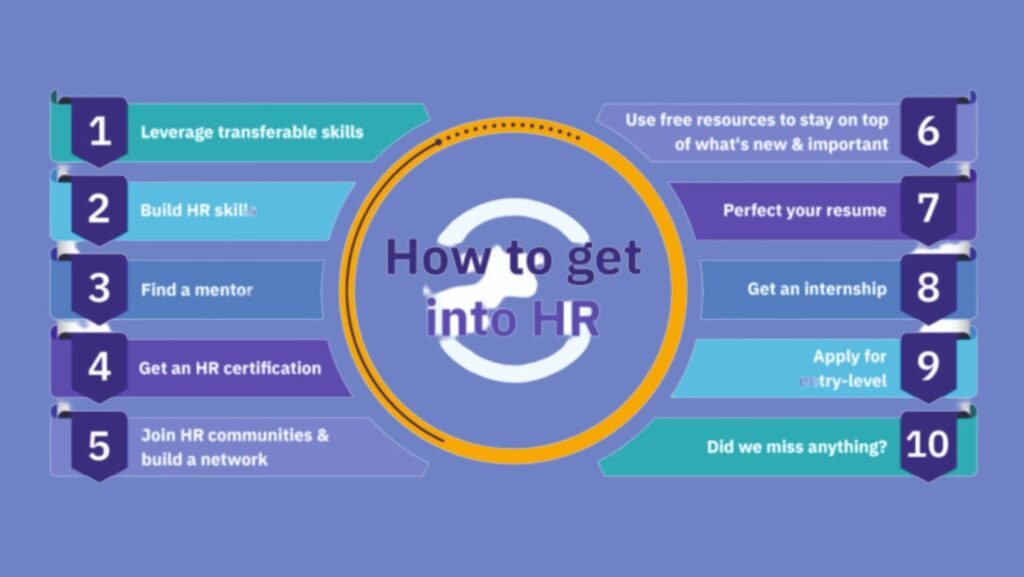
1. Gain Relevant Education
Obtaining a relevant education is a solid foundation for starting a career in HR. Consider pursuing a bachelor’s degree in business administration, human resources, business administration, psychology, or a related field. These programs provide a comprehensive understanding of HR principles, employment laws, organizational behavior, and other relevant topics. Additionally, obtaining a master’s degree in business administration or HR or pursuing HR certifications can further enhance your knowledge and credibility in the field.
- List of HR Certifications
HR certifications are valuable credentials that demonstrate expertise and competence in the field of Human Resources (HR). They enhance professional credibility, open up new career opportunities, and validate knowledge and skills. If you’re interested in pursuing an HR certification, here are some well-recognized certifications to consider:
The Professional in Human Resources (PHR) certification is offered by the HR Certification Institute (HRCI). It validates the foundational knowledge and skills required for HR professionals in areas such as employee relations, recruitment, compensation, and HR operations. The PHR certification is ideal for HR professionals with a few years of experience in HR roles.
The Senior Professional in Human Resources (SPHR) certification is also provided by the HR Certification Institute (HRCI). It is designed for HR professionals who have more extensive experience and advanced responsibilities in HR management. The SPHR certification demonstrates mastery of strategic HR planning, organizational development, and HR leadership.
The Society for Human Resource Management (SHRM) offers the Certified Professional (SHRM-CP) certification. It is a globally recognized certification that focuses on both HR competencies and behavioral competencies necessary for effective HR practice. The SHRM-CP certification is suitable for HR professionals who have a solid understanding of HR principles and a few years of practical HR experience.
The Society for Human Resource Management (SHRM) also provides the Senior Certified Professional (SHRM-SCP) certification. This certification is for experienced HR professionals who have demonstrated advanced knowledge and skills in strategic HR planning, organizational effectiveness, and leadership. The SHRM-SCP certification signifies a high level of expertise and proficiency in HR management.
The Certified Professional in Learning and Performance (CPLP) certification is offered by the Association for Talent Development (ATD). It focuses on the knowledge and skills required for training and development professionals. The CPLP certification demonstrates expertise in instructional design, training delivery, talent management, and evaluating learning impact.
The Global Professional in Human Resources (GPHR) certification is provided by the HR Certification Institute (HRCI). It is specifically designed for HR professionals working in international HR roles. The GPHR certification validates knowledge and skills in global HR practices, cross-border HR management, and international employment laws.
The Certified Compensation Professional (CCP) certification is offered by WorldatWork. It focuses on compensation and benefits management and demonstrates expertise in designing and implementing compensation strategies, conducting job analysis, and administering total rewards programs.
The Certified Employee Benefits Specialist (CEBS) certification is jointly offered by the International Foundation of Employee Benefit Plans (IFEBP) and the Wharton School of the University of Pennsylvania. It covers a comprehensive range of employee benefits topics, including health and welfare plans, retirement plans, and strategic planning for benefits.
These are just a few examples of HR certifications available in the industry. Each certification has its own eligibility requirements, application process, and exam criteria. As you consider pursuing an HR certification, carefully evaluate the requirements and choose the one that aligns with your experience, career goals, and professional aspirations.
Remember that obtaining an HR certification requires dedication, preparation, and ongoing professional development. However, the investment in obtaining an HR certification can significantly enhance your HR career prospects and demonstrate your commitment to the field.
2. Acquire Practical Experience
While education is important, practical experience is equally valuable in the HR field. Look for opportunities to gain experience through internships, part-time jobs, or volunteer positions in HR departments. This hands-on experience will allow you to apply theoretical knowledge in real-world scenarios, develop practical skills, and make valuable industry connections.
3. Develop HR Skills
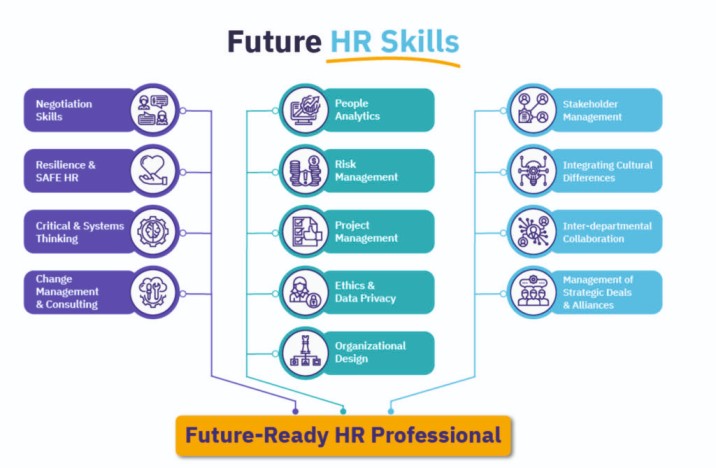
To excel in HR, it’s essential to develop a set of key skills. These skills include:
- Communication: Strong communication skills, both written and verbal, are crucial for effective HR professionals. HR professionals regularly interact with employees, managers, and stakeholders, requiring the ability to communicate clearly, empathetically, and professionally.
- Interpersonal Skills: HR professionals often deal with sensitive and confidential matters, requiring strong interpersonal skills. Building relationships, resolving conflicts, and fostering positive employee relations are vital aspects of the HR role.
- Problem-Solving: HR professionals need strong problem-solving abilities to address various HR challenges. They must analyze situations, identify root causes, and develop practical and ethical solutions.
- Organizational Skills: HR professionals handle multiple tasks simultaneously, so strong organizational and time management skills are essential. Being able to prioritize tasks, manage deadlines, and pay attention to detail is critical for success in HR roles.
Free Online Courses for HR
Human Resource Development
Course Provider: Human Resource Development via YouTube
- Free online course
- 1of 61 Videos
The Future of Human Resource Management (HRM)
Course Provider: University of Twente
- Free Online Course (Audit)
- English
- $164.00 Certificate Available
- 10 weeks long, 3 hours a week
Human Resource Management: Skills Development & Training
Course Provider: Study.com
- Paid Course
- English
- Paid Certificate Available
- 14 hours worth of material
- On-Demand
What is strategic human resource management?
Course Provider: The Open University
- Free Certificate
- English
- Certificate Available
- 4 hours worth of material
- On-Demand
Human Resource Management | Performance Management | Great Learning
Course Provider: Great Learning via YouTube
Challenges in Human Resource Management
Course Provider: The Open University
- Free Online Course (Audit)
- English
- $64.00 Certificate Available
- 2 weeks long, 3 hours a week
Preparing to Manage Human Resources
Course Provider: University of Minnesota
- Free Online Course (Audit)
- English
- Paid Certificate Available
- 4 weeks long
Human Resources Management Capstone: HR for People Manager
Course Provider: University of Minnesota
- Free Online Course (Audit)
- English
- Paid Certificate Available
- 7 weeks long
Human Resources: Hiring and Managing Talent in the 21st Century
Course Provider: University of California, Riverside
- Free Online Course (Audit)
- English
- $164.00 Certificate Available
- 8 weeks long, 2 hours a week
4. Network and Stay Updated
Networking is valuable for building relationships and staying updated on industry trends. Join professional HR associations, attend conferences, seminars, and workshops related to HR, and engage in online HR communities. Networking provides opportunities to learn from experienced professionals, gain insights into industry best practices, and potentially uncover job opportunities.
6. Start with Entry-Level Positions
When beginning your HR career, be open to starting with entry-level positions such as HR Assistant, HR Coordinator, or Recruitment Assistant. These roles provide valuable hands-on experience, exposure to different HR functions, and opportunities for growth and advancement within the organization.
7. Continuously Learn and Grow
The field of HR is constantly evolving, so it’s essential to stay updated on industry trends, changes in employment laws, and emerging practices. Engage in continuous learning by attending professional development programs, webinars, and training sessions. Additionally, seek feedback from mentors and supervisors to identify areas for improvement and proactively seek growth opportunities.
Starting a career in HR requires a combination of education, practical experience, skills development, networking, and a passion for working with people. By following these steps, you can embark on a fulfilling and rewarding career in HR. Good luck on your HR journey!
What is the Salary Range for HR?
The salary of HR professionals can vary based on factors such as job level, experience, industry, and location. Here is a breakdown of the expected salary ranges for HR professionals at different levels:
- Low or Entry Level:
- Staffing Coordinator: ₹14,320 per hour
- Staffing Specialist: ₹14,650 per hour
- HR Assistant: ₹15,200 per hour
- HR Associate: ₹15,860 per hour
- Mid-level:
- Personnel Manager: ₹2.6 lakhs to ₹18.4 lakhs per year
- HR Specialist: ₹2.4 lakhs to ₹14 lakhs per year
- HR Generalist: ₹2 lakhs to ₹8.4 lakhs per year
- HR Supervisor: ₹2 lakhs to ₹12 lakhs per year
- HR Analyst: ₹2.5 lakhs to ₹8.9 lakhs per year
- Senior Level:
- HR Manager: ₹9 lakhs to ₹20 lakhs per year
- HR Director: ₹10 lakhs to ₹98 lakhs per year
- Chief HR Officer: ₹15.6 lakhs to ₹102 lakhs per year
It’s important to note that these salary ranges are indicative and can vary based on factors such as company size, industry, geographic location, and individual qualifications. Additionally, HR professionals may also receive benefits, bonuses, and other forms of compensation in addition to their base salary.
As the HR profession continues to evolve and gain importance in organizations, the demand for skilled HR professionals remains high, which can positively impact salary growth opportunities.
Conclusion
Human Resources (HR) plays a vital role in managing and optimizing the workforce within organizations. From recruitment to employee development, performance management to employee engagement, and ensuring compliance with employment laws, HR professionals are at the heart of creating a conducive work environment. Their efforts contribute to the overall success and growth of the organization by fostering positive employee experiences and driving productivity. Understanding the significance of HR and its multifaceted functions is crucial for organizations aiming to thrive in today’s competitive landscape.
FAQs
1. How can I pursue a career in HR?
To pursue a career in Human Resources (HR), you can follow these steps:
Educational Background: Obtain a relevant educational background, typically a bachelor’s degree in Human Resources, Business Administration, Psychology, or a related field. Some positions may require a master’s degree for more advanced roles.
Gain Relevant Skills: Develop skills such as communication, interpersonal relations, problem-solving, organizational skills, and attention to detail. Proficiency in using HR software and tools is also important.
Internships and Entry-Level Positions: Look for internships or entry-level HR positions to gain practical experience. These roles might involve assisting with recruitment, onboarding, administrative tasks, and employee relations.
Networking: Attend HR-related seminars, workshops, and conferences to connect with professionals in the field. Networking can provide valuable insights and potential job opportunities.
Certifications: Consider obtaining HR certifications, such as PHR (Professional in Human Resources) or SHRM-CP (Society for Human Resource Management Certified Professional). These certifications can enhance your credibility and job prospects.
Specialization: HR is a diverse field with various specializations like recruitment, employee relations, training and development, compensation and benefits, etc. Choose an area that aligns with your interests and strengths.
Continuous Learning: Stay updated with the latest trends and developments in HR by reading industry publications, blogs, and attending webinars or workshops.
Progression: As you gain experience, you can move up the career ladder from entry-level positions to more senior roles like HR Manager, HR Director, or even Chief Human Resources Officer (CHRO).
Soft Skills Development: As you advance in your career, focus on developing leadership, strategic thinking, and conflict resolution skills. These qualities are crucial for managing teams and contributing to an organization’s overall success.
Contribute to the Field: Consider writing articles, giving presentations, or participating in HR-related discussions to establish yourself as a thought leader in the HR community.
Remember that HR is a dynamic field that requires adaptability and a genuine interest in working with people. By following these steps and continuously improving your skills and knowledge, you can build a rewarding career in Human Resources.
2. What are some emerging trends in HR?
Remote Work and Flexible Work Arrangements: The COVID-19 pandemic has accelerated the adoption of remote work. As a result, HR professionals are focusing on creating flexible work policies, ensuring employee engagement in virtual settings, and providing the necessary tools and technologies for remote collaboration.
Employee Well-being and Mental Health: Employers are increasingly recognizing the importance of employee well-being and mental health. HR is implementing programs and resources to support employees’ mental, emotional, and physical well-being, both in office and remote environments.
Data-Driven Decision-Making: HR departments are leveraging data analytics to make informed decisions about talent management, employee performance, recruitment strategies, and more. This trend helps in predicting trends, identifying areas of improvement, and optimizing HR processes.
Diversity, Equity, and Inclusion (DEI): Organizations are placing a greater emphasis on creating diverse, equitable, and inclusive workplaces. HR is responsible for implementing strategies to ensure equal opportunities, address biases, and foster a culture of belonging.
Upskilling and Reskilling: Rapid technological advancements are leading to shifts in job roles. HR is focusing on providing opportunities for employees to upskill or reskill to meet changing job requirements, thereby enhancing their career growth within the organization.
Artificial Intelligence (AI) in HR: AI is being used for various HR functions, including resume screening, chatbots for employee queries, predictive analytics for workforce planning, and improving the candidate experience during the recruitment process.
Remote Onboarding and Training: With remote work becoming more prevalent, HR is adapting by developing effective remote onboarding processes and providing virtual training programs to ensure new and existing employees have the necessary skills for their roles.
Agile HR: Borrowing concepts from agile project management, Agile HR focuses on quick adaptability, flexibility, and collaboration to address changing organizational needs. It involves cross-functional teams and iterative approaches to HR processes.
Gig Economy Management: As the gig economy continues to grow, HR is tasked with effectively managing a blended workforce of full-time employees, part-time workers, freelancers, and contractors.
Employee Experience (EX): HR is shifting its focus from traditional HR processes to creating a positive employee experience. This includes improving communication, providing growth opportunities, and ensuring a seamless employee journey within the organization.
Automation of Administrative Tasks: HR is increasingly automating repetitive administrative tasks such as payroll processing, benefit administration, and leave tracking, allowing HR professionals to focus on strategic initiatives.
These trends are reshaping the way HR functions within organizations. Staying updated on these developments and incorporating them into HR strategies can help organizations attract, retain, and develop talent effectively in a rapidly changing business landscape.
3. How can HR contribute to organizational strategy?
Talent Acquisition and Planning: HR can collaborate with business leaders to understand the organization’s strategic goals and identify the required skills and competencies. By aligning recruitment efforts with these needs, HR ensures that the workforce is capable of driving the company’s strategic initiatives.
Workforce Development: HR can design training and development programs that enhance employees’ skills, aligning them with the organization’s evolving needs. This ensures that employees are prepared for new challenges and opportunities that arise from strategic changes.
Succession Planning: HR can identify high-potential employees and develop succession plans for key leadership roles. This proactive approach ensures that the organization has a pool of capable leaders ready to step into critical positions when needed.
Performance Management: HR can establish performance metrics and objectives that are directly tied to the organization’s strategic goals. Regular performance evaluations can help ensure that employees’ contributions align with the company’s strategic direction.
Employee Engagement and Retention: HR can create an engaging and inclusive work environment that supports the organization’s culture and values. Engaged employees are more likely to be committed to the company’s strategic vision and goals.
Change Management: During periods of organizational change, HR can facilitate smooth transitions by communicating changes effectively, addressing employee concerns, and providing the necessary support to ensure employees are on board with the strategic shifts.
Diversity and Inclusion: HR can drive initiatives to foster a diverse and inclusive workforce. Diverse teams bring varied perspectives that can enhance decision-making and innovation, aligning with the organization’s strategic objectives.
HR Analytics and Data-Driven Insights: HR can use data analytics to provide insights into workforce trends, helping leaders make informed decisions about resource allocation, talent development, and strategic planning.
Employee Well-being: HR can prioritize employee well-being, recognizing that a healthy and motivated workforce is better positioned to contribute effectively to the organization’s strategic goals.
Alignment of Organizational Culture: HR can reinforce the organization’s values and desired culture through its policies, practices, and communication strategies. A strong cultural alignment supports the implementation of strategic initiatives.
Collaboration with Leadership: HR professionals should actively collaborate with senior leadership to understand the organization’s long-term goals, challenges, and opportunities. This collaboration ensures that HR strategies are directly tied to the overall business strategy.
By integrating these HR practices into the strategic planning process, HR professionals can enhance their role as strategic partners in driving the success of the organization. The key is to align HR practices with the company’s vision, ensuring that every HR initiative contributes to achieving the larger strategic objectives.
4. What is the role of HR in employee training and development?
Identifying Training Needs: HR collaborates with department heads and managers to identify skill gaps and training needs within the organization. This involves understanding the company’s strategic goals and the skills required to achieve them.
Designing Training Programs: HR designs training programs that address the identified needs. These programs can include on-the-job training, workshops, seminars, e-learning modules, and more. The content and format of training are tailored to match the learning preferences of employees.
Selecting Training Methods: HR determines the most effective training methods based on the content, audience, and desired outcomes. This might involve in-house training, external trainers, online courses, workshops, mentoring, or a combination of these approaches.
Sourcing Training Resources: HR is responsible for sourcing training materials, resources, and trainers, whether internally or externally. This ensures that employees receive high-quality training that aligns with the organization’s goals.
Scheduling and Coordination: HR manages the logistics of training, including scheduling sessions, booking venues, arranging trainers, and communicating training details to participants.
Employee Development Plans: HR collaborates with managers to create individual development plans for employees. These plans outline the skills and competencies employees need to develop over time to meet their career goals and contribute effectively to the organization.
Performance Appraisal Integration: HR aligns training and development initiatives with the organization’s performance appraisal process. This ensures that employees’ growth and development are linked to their performance evaluations.
Evaluating Training Effectiveness: HR assesses the effectiveness of training programs through feedback surveys, assessments, and performance metrics. This evaluation helps identify the impact of training on employee performance and the organization’s overall goals.
Continuous Learning Culture: HR promotes a culture of continuous learning by encouraging employees to seek growth opportunities, offering ongoing training resources, and showcasing the value of professional development.
Leadership Development: HR identifies and nurtures potential leaders within the organization by providing leadership development programs and mentorship opportunities.
Technical and Soft Skills Training: HR offers training that covers both technical skills (job-specific knowledge) and soft skills (communication, leadership, teamwork) to ensure employees are well-rounded and adaptable.
Career Development Support: HR assists employees in planning their career paths within the organization, providing guidance on advancement opportunities and the skills required for various roles.
Budget Management: HR manages the budget allocated for training and development initiatives, ensuring efficient use of resources and a positive return on investment.
In summary, HR plays a pivotal role in enhancing the skills, knowledge, and capabilities of employees through well-designed training and development programs. By providing opportunities for growth, HR contributes to building a motivated and competent workforce that can drive the organization’s success.
5. How does HR support diversity and inclusion in the workplace?
Policy Development: HR develops and implements policies that promote diversity and inclusion, such as equal opportunity employment, non-discrimination, and anti-harassment policies.
Diverse Hiring Practices: HR implements practices to attract a diverse pool of candidates during recruitment. This includes writing inclusive job descriptions, using unbiased language, and exploring diverse recruitment channels.
Inclusive Recruitment: HR ensures that recruitment and selection processes are fair and unbiased. This includes providing training to interviewers on unconscious bias, conducting diverse interview panels, and using standardized assessment criteria.
Diversity Training: HR provides training for employees and managers on diversity awareness, cultural sensitivity, and inclusion practices to foster a respectful and inclusive workplace.
Inclusive Onboarding: HR ensures that the onboarding process includes information about the organization’s commitment to diversity and inclusion, as well as resources for employees to understand and embrace the company’s diverse culture.
Employee Resource Groups (ERGs): HR supports the formation and activities of ERGs, which are voluntary groups that provide a platform for employees from various backgrounds to connect, share experiences, and contribute to a more inclusive workplace.
Leadership Training: HR offers leadership development programs that emphasize the importance of inclusive leadership, enabling managers to create environments where diverse perspectives are valued.
D&I Metrics and Reporting: HR collects data on diversity and inclusion metrics, such as representation at different levels and demographics. This data helps in measuring progress and identifying areas for improvement.
Addressing Biases and Microaggressions: HR educates employees on identifying and addressing biases and microaggressions, while also providing clear channels for reporting such incidents.
Accommodations and Accessibility: HR ensures that workplace facilities and practices are accessible to all employees, including those with disabilities. This may involve making physical modifications and offering accommodations as needed.
Inclusive Benefits and Policies: HR reviews benefits and policies to ensure they are inclusive and accommodate diverse needs, such as family-friendly policies, gender-neutral restrooms, and religious accommodations.
Career Development Opportunities: HR supports equal access to growth and development opportunities for all employees, helping to break down barriers and create pathways for advancement.
D&I Advocacy: HR collaborates with executive leadership to advocate for diversity and inclusion initiatives and secure the necessary resources to support them.
Supplier Diversity: HR can influence supplier selection processes to prioritize working with diverse suppliers and vendors, contributing to a broader ecosystem of inclusion.
Creating an Inclusive Culture: HR fosters an environment where employees feel valued, respected, and included through open communication, transparency, and strong leadership support.
By integrating these practices into HR strategies, organizations can create an inclusive workplace culture that recognizes and celebrates the unique contributions of all employees, ultimately leading to increased employee engagement, innovation, and overall success.

